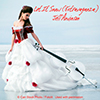The Major Scale and Its Diatonic Triads

The major scale is arguably the most important scale in Western music. It is found across many genres, including classical, jazz, folk, pop, rock, country, and more. It is an important weapon in any musician's arsenal, with application in the areas of theory, improvisation, composition, arranging, and technique. It is almost the "Super Man" among scales. Within it can be found three of the four basic triads - major, minor, and diminished. (The fourth basic triad, augmented, can be easily created with a simple alteration.) As we will see below, it is a godsend to improvisors. A single major scale will work for an entire composition if the piece uses only the "diatonic" notes (the notes in the scale) in a major key.
Constructing a Major Scale
Constructing a major scale is easy if you follow just two simple rules:
- A major scale is based on a standard series of whole steps (abbreviated "W" and equivalent to two half-steps/frets) and half steps (abbreviated "H" and equivalent to one half-step/fret): W W H W W W H. (A half-step/fret is the smallest distance between two notes, such as going from B to C. Half-steps/frets are measured exclusively, like inches or centimeters. Another type of measurement in music, size, is counted inclusively.)
- Major scales are always written using consecutive letter names. No skipping allowed! A one-octave (eight note) c major scale contains the following notes: C D E F G A B C. Happily, this sequence of natural notes (no sharps or flats) follows the W W H W W W H formula of rule one.
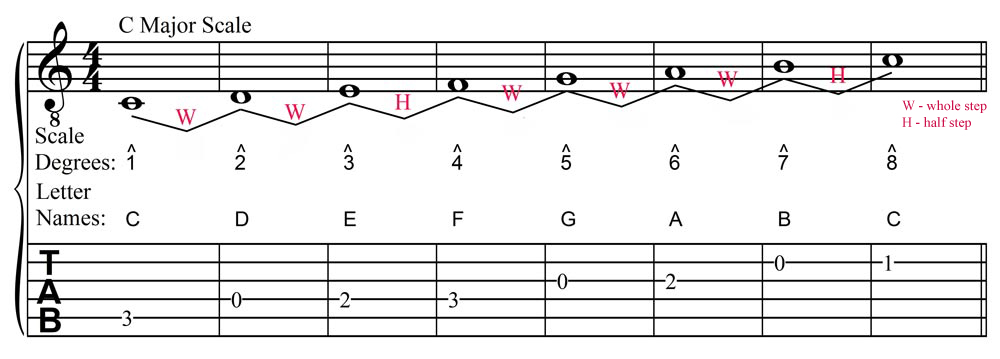
The C Major Scale
The Diatonic Triads of a Major Scale
The major scale in itself is cool enough, but the real magic occurs when you use it to construct chords. Chords are usually made like sandwiches: a piece of bread on the bottom, then some peanut butter, and then a piece of bread on the top. You might try to create a sandwich using only bread, but that wouldn't really be a sandwich, would it? A sandwich made only of bread would be a scale. You have to layer things to make sandwiches and chords.
If you are building a chord, you usually skip every other letter name (there are always exceptions in music) - such as C (bread), then E (peanut butter), then G (bread). Notice that I skipped the letter names D and F?
Music theorists call the distance between any two notes an interval. Sizes are measured using the music alphabet: A, B, C, D, E, F, and G. (The joke is that musicians never learned the whole alphabet when they were in kindergarten.) The size of the intervals created when you skip just one note is called a third. (Sizes are measured inclusively: for example, C to E is counted C, D, E - one, two, three.) Simply put, chords are usually built in thirds.
When we use the major scale to build simple chords called triads - chords containing only three different letter names - we get a series of seven chords. Because we use only the notes that are contained in the scale, we call these "diatonic" triads. A triad is the simplest type of chord. There are four basic kinds: major, minor, diminished, and augmented. (More about these later and at this web page.) Here are the seven diatonic chords found using the c major scale. Notice that each one is constructed by using every other letter name (thirds) from the c major scale, C D E F G A B C.
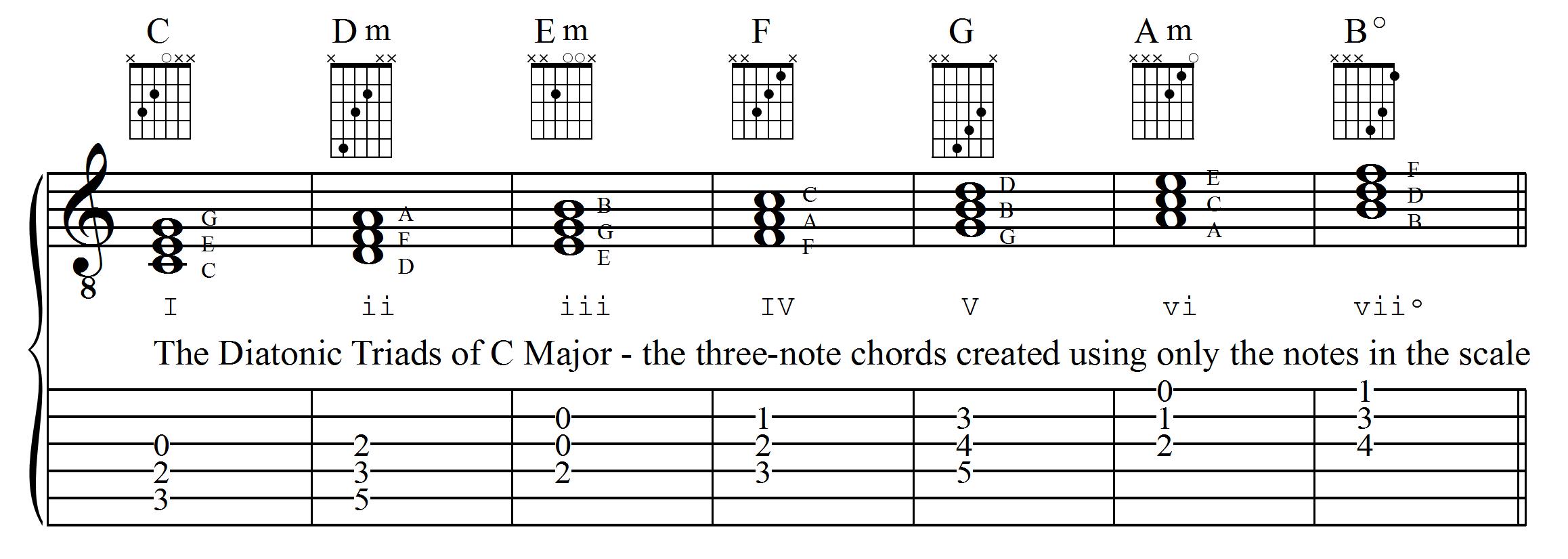
The Diatonic Triads of C Major
The chord symbol "C" is an abbreviation for "C Major". That's a major chord. The chord symbol "Dm" is an abbreviation for "D Minor", which is a minor chord. A rarer type of triad, called diminished, is what "Bo" stands for - a "B Diminished" triad. Music theorists often use Roman numerals to quickly designate both the quality of a chord and the scale degree it is built on. Upper case Roman numerals are used for major chords, lower case for minor chords, lower case with a superscript "o" for diminished chords, and upper case Roman numerals with a superscript "+" designate augmented chords. Hence, an upper case "I" means a major chord constructed on the first scale degree.
If you have studied the text and examples above fairly closely, you will understand why a major scale works so well when improvising over the diatonic chords in a major key. Every single note in the scale is found in the diatonic triads and vice versa. It is almost like spraying white paint on white walls.
The Four Basic Types of Chords
Major, Minor, Diminished, and Augmented Triads
Chords are constructed of at least three different letter names. The most basic kind of chord is called a triad. A triad uses only three different letter names.
The notes of a chord are called "members". The members of a c major chord are the notes c, e, and g. CONFUSING FACT: Chords are by definition made of three or more different letter names. An exception to this rule - a power chord - has only two different letter names.
There are four different kinds of triads: major, minor, diminished, and augmented. Each type has a slightly different construction.
In music we have two different ways of measuring distances, quality, half steps (frets), and size (letter names/lines and spaces). We've already learned that chords are usually built using intervals called thirds. Intervals are named by counting letter names (or lines and spaces on the staff). Unfortunately all letter names are not the same number of half steps apart, so we must also count half steps. For example, the number of half steps from B to C is one, while there are two half steps from C to D. Check out these examples using a piano keyboard and a guitar fretboard.

Since triads are built of thirds - one type of measurement called the size - we can distinguish between different kinds of triads by counting half steps (quality) - the second method of measuring intervals. With both of these measurement tools in our tool box, we can now differentiate between the four different kinds of triads.
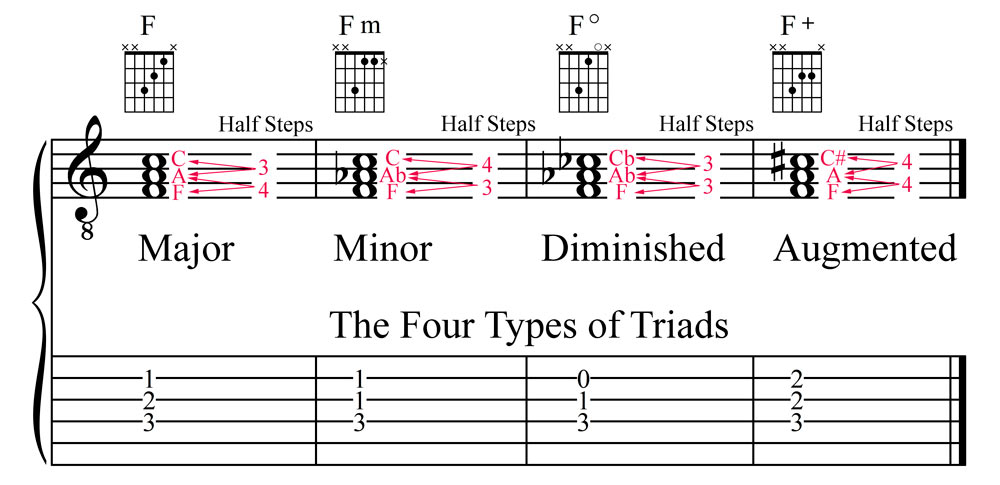
The Four Types of Triads
Having two different measurement systems can be very confusing, but if you can clearly distinguish between them, music theory will become much easier to understand.
The Major Scale in Improvisation
To an improvisor, the major scale is a good choice when soloing over diatonic chords in a major key. It is also a good choice when soloing over major chords. Used in the proper context it will work well with more complicated chords if the notes of the chord correspond to notes in the scale. The well-trained improvisor will be able to use the major scale in many other ways beyond the scope of this article.
Major Scale Forms for Guitarists
Shown below are the five forms most often used by guitar players, followed by a full fingerboard layout. If you would like to download a PDF of the five scale forms, click here. The numbers enclosed in squares are scale degrees, while the letter "R" (root) designates the tonic, or keynote. While scales do not technically have roots, guitarists have traditionally referred to the tonic as the root. (Chords have roots while scale have tonics.)
Jeff Anvinson, owner/operator of JLA Music
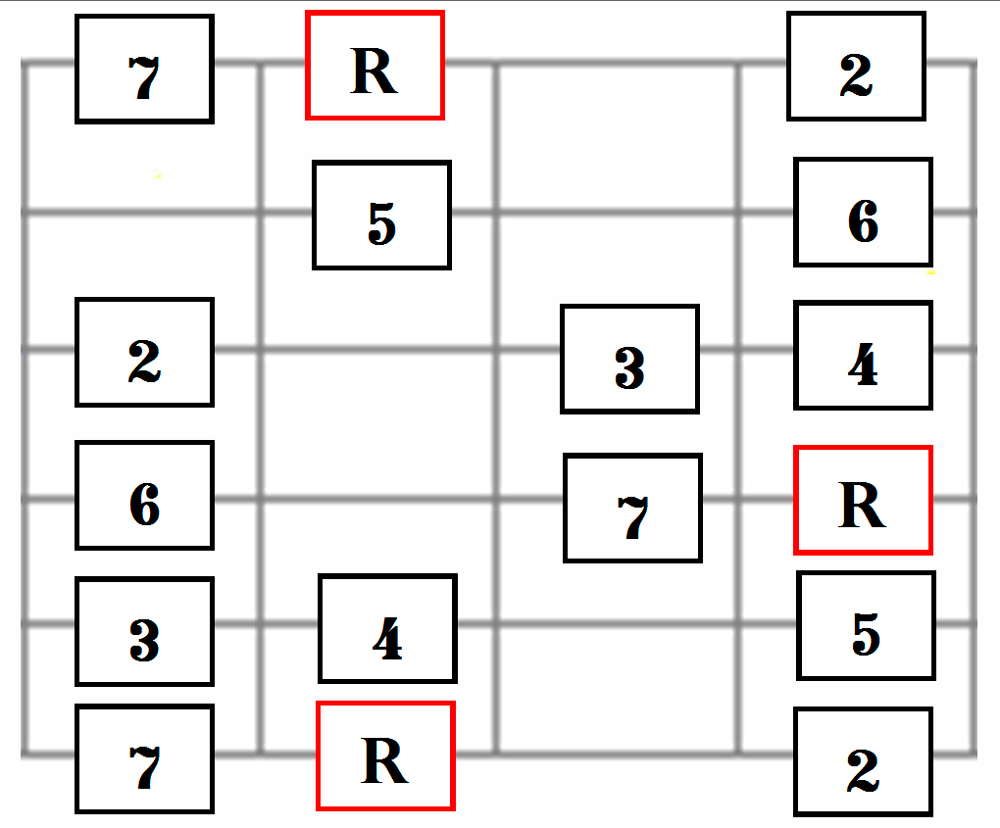
Major Scale Form 1
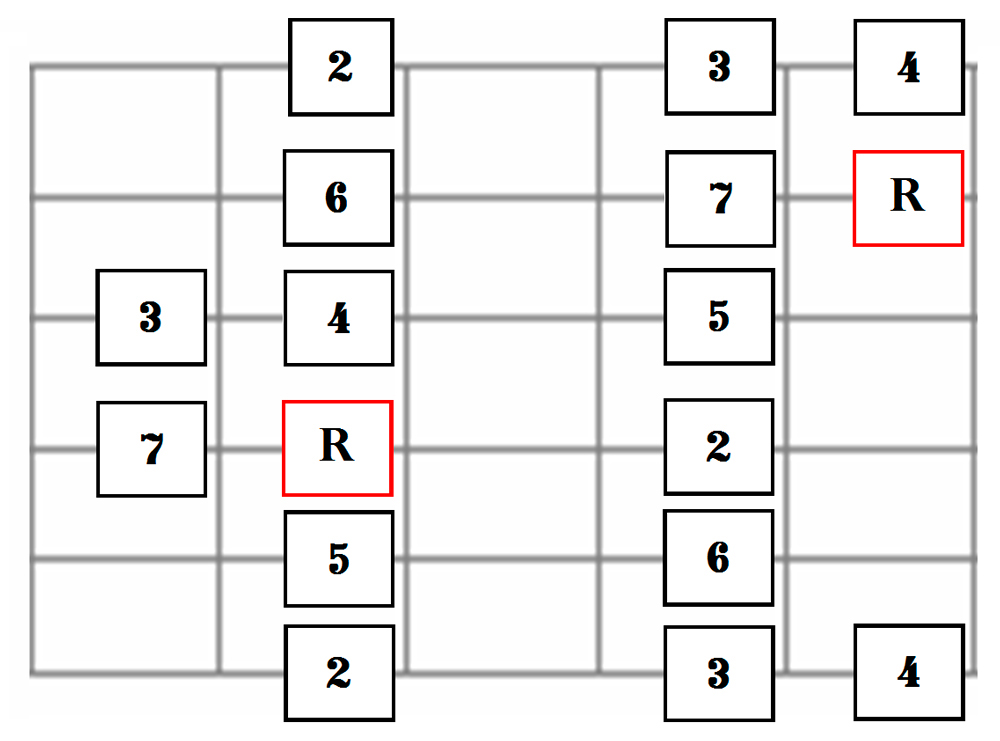
Major Scale Form 2
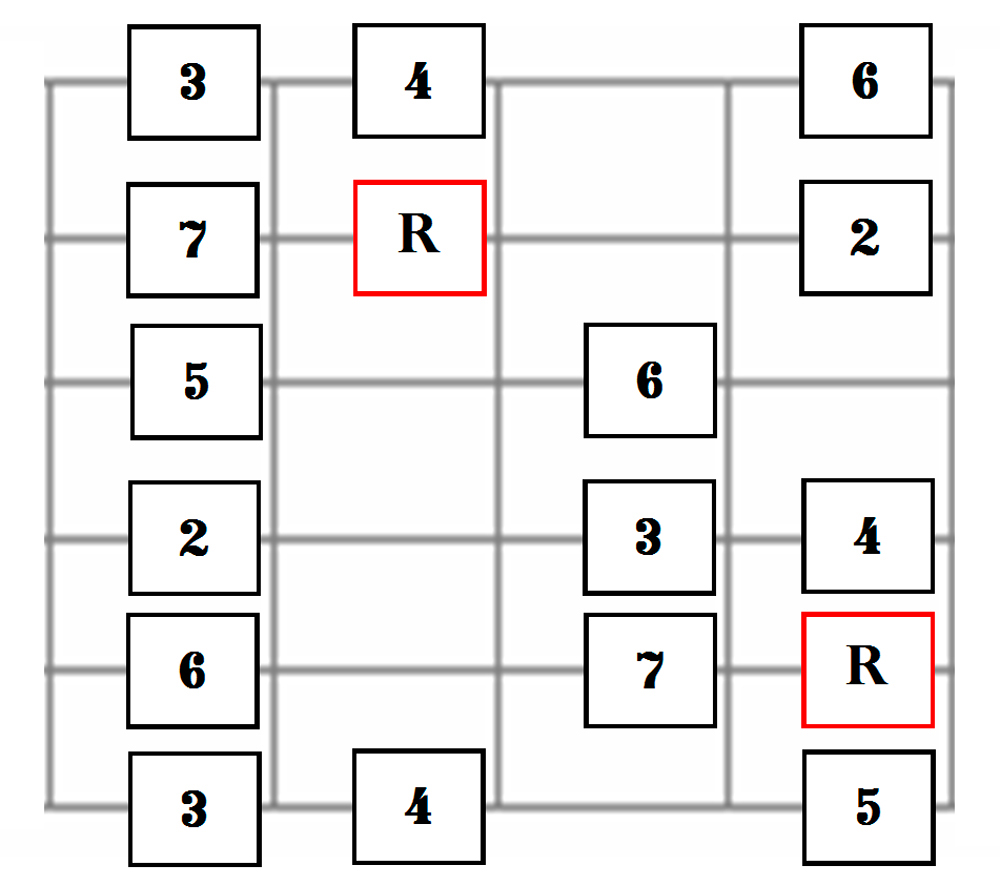
Major Scale Form 3
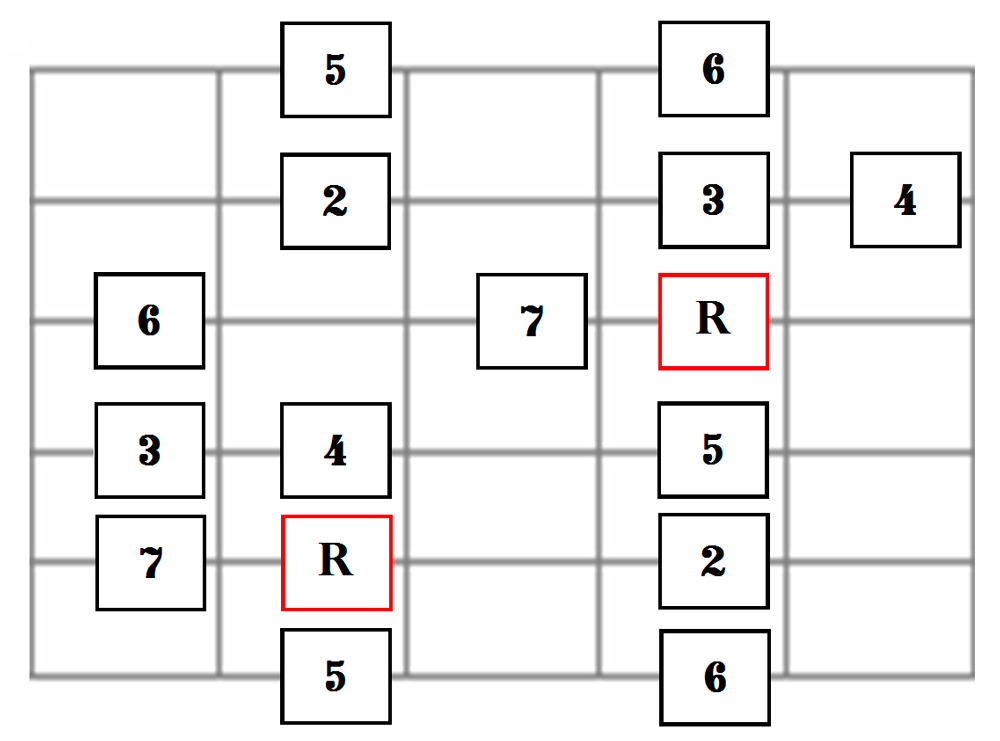
Major Scale Form 4
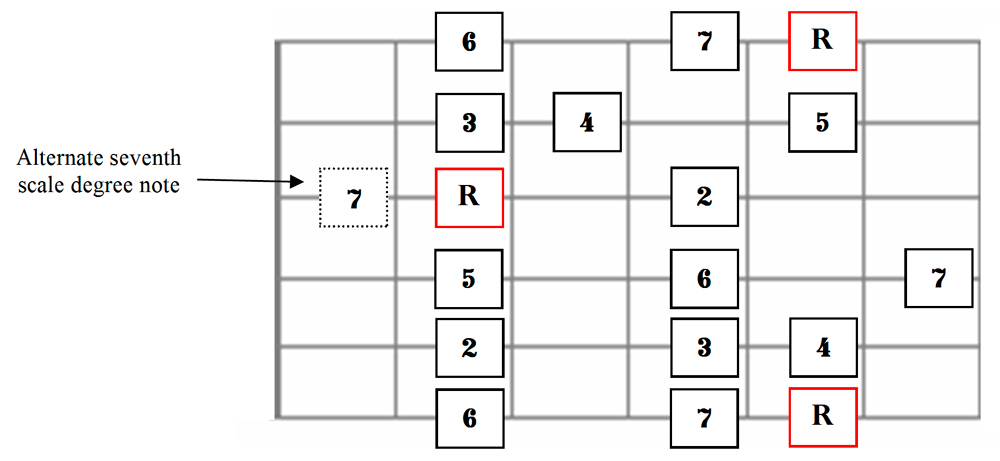
Major Scale Form 5

Full Fingerboard Layout of the Major Scale for Guitar
Website and most graphics are created inhouse by Jeff Anvinson, Owner/Operator of JLA Music
Some graphics are purchased from Can Stock Photo, used by permission, and are Copyright
© Can Stock Photo
JLA Music takes care not to infringe on anyone's rights. Please contact us at jla@jlamusic.com if you have questions.
Copyright 2025 © Jeff Anvinson, JLA Music


